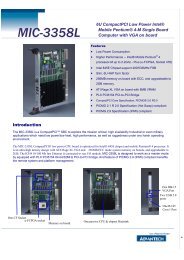industrial wireless book special edition - Networking ...
industrial wireless book special edition - Networking ...
industrial wireless book special edition - Networking ...
You also want an ePaper? Increase the reach of your titles
YUMPU automatically turns print PDFs into web optimized ePapers that Google loves.
I n d u s t r i a l W i r e l e s s<br />
44<br />
Waiting in the wings – ISA-100.11a<br />
This article was written for last year's<br />
Embedded Systems conference and before ISA<br />
ratified its Wireless for Process Automation<br />
specification in September of this year. We feel<br />
that Joel Young's paper would not be complete<br />
without a suitable update.<br />
With Honeywell as its highest profile backer,<br />
the ISA-100.11a standard 'Wireless Systems<br />
for Industrial Automation: Process Control and<br />
Related Applications' is a mesh network built<br />
on an IEEE802.15.4 MAC and physical layer,<br />
TDMA mesh protocol (as championed by Dust<br />
Networks), uses the WirelessHART-style DSSS<br />
frequency hopping for interference mapping<br />
and avoidance. It also of course implements<br />
mesh routing.<br />
ISA describes the protocol as providing 'reliable<br />
and secure <strong>wireless</strong> operation for non-critical<br />
monitoring, alerting, supervisory control, open<br />
loop control, and closed loop control<br />
applications. The standard defines the protocol<br />
suite, system management, gateway, and<br />
security specifications for low-data-rate<br />
<strong>wireless</strong> connectivity with fixed, portable, and<br />
moving devices supporting very limited power<br />
consumption requirements.'<br />
The application focus is on applications such<br />
as monitoring and process control where<br />
latency in the order of 100ms can be tolerated,<br />
with optional behaviour for shorter latency. The<br />
declared aim is to provide reliable and secure<br />
<strong>wireless</strong> operation for non-critical monitoring,<br />
alerting, supervisory control, open loop control,<br />
and closed-loop control applications.<br />
While the first version requires network<br />
connection through a gateway and does not<br />
directly support IP-based address space at<br />
device level, other ISA working groups plan<br />
coexistence with other <strong>industrial</strong> <strong>wireless</strong><br />
devices based on IEEE 802.11x, IEEE 802.15x,<br />
IEEE 802.16x, and other relevant standards.<br />
This plan includes ISA-100 proposals capable<br />
of direct network addressing using IPv6.<br />
Frank Ogden<br />
The ZigBee standard has evolved in three<br />
different versions: 2004, 2006 and 2007. ZigBee<br />
2004 is no longer used and ZigBee 2006 had<br />
significant limitations. ZigBee 2007 includes<br />
key features for frequency agility, message fragmentation,<br />
and enhanced security associated<br />
with key management. The routing of messages<br />
follows Cluster Tree methodology where routes<br />
to all points are maintained at each cluster. This<br />
allows a very short routing time, but requires<br />
many routes. Discovery of routes uses the AODV<br />
algorithm where paths are explored between<br />
clusters. A ZigBee release using IPv6 addressing<br />
is presently under development.<br />
Network Architecture. The network consists<br />
of three specific device types. A ZigBee<br />
Coordinator (ZC) is required for each network<br />
to initiate network formation. The coordinator<br />
may act as a router once the network is formed.<br />
The ZigBee Router (ZR) is actually an optional<br />
network component, although a network<br />
without routers becomes a point to multipoint<br />
network. The router participates in multi-hop<br />
routing of messages. Finally, the ZigBee End<br />
Device (ZED) does not allow association and<br />
Fig. 4. ZigBee network<br />
example. End points<br />
sleep, routers don’t sleep<br />
and a coordinator is<br />
needed to start the<br />
network and to allow<br />
points to join the<br />
network.<br />
does not participate in routing. Figure 4 illustrates<br />
an example network.<br />
Strengths. End devices consume very low<br />
power. Cluster Tree routing provides quick<br />
knowledge of routes and thereby efficient<br />
routing. With ZigBee 2007, frequency agility<br />
skips interference-prone channels automatically.<br />
Long messages are allowed with message<br />
fragmentation support and security is flexible<br />
with support of separated keys. Finally, the<br />
network can scale to very large.<br />
Limitations. Routers must be powered at all<br />
times: no sleep mode. Cluster Tree routing<br />
creates heavy route discovery traffic on network<br />
changes. Heavy traffic volume produces<br />
collisions and potential message loss. A coordinator<br />
is needed to start and manage the<br />
network: if the coordinator goes down, the<br />
network can’t start.<br />
WirelessHART<br />
Key Characteristics. WirelessHART uses the<br />
Time Synchronised Mesh Protocol created by<br />
Dust Networks. Unlike other networks, the timebased<br />
system uses TDMA as access method. The<br />
network is optimised for low power and all<br />
nodes can be sleeping routers and every node<br />
is a router. A Gateway is required to implement<br />
the critical time synchronisation of sleeping<br />
and waking functions. Like ZigBee, it uses<br />
Fig. 5. WirelessHART network example. A Gateway is<br />
required to implement the critical time synchronisation of<br />
sleeping and waking functions.<br />
<strong>industrial</strong> ethernet <strong>book</strong><br />
802.15.4 DSSS, with the addition of a more<br />
advanced frequency hopping algorithm. Security<br />
includes encryption and authentication.<br />
Network Architecture. Note that all the nodes<br />
are routers. Figure 5 illustrates a typical network<br />
topology. The illustrated routes change dynamically<br />
based on visibility within specific time slots<br />
as it hops through the different DSSS channels.<br />
The relationship between any two nodes is<br />
negotiated to be in a specific time slot, thereby<br />
minimising the probability of any collisions.<br />
When sleeping, nodes awaken during their time<br />
slot and listen to see if there is any traffic. Clocks<br />
are kept synchronised by the gateway.<br />
Strengths. Every node provides a routing<br />
function with very low power consumption.<br />
Since transmissions occur only within the<br />
allocated time slot, retransmissions are<br />
minimised. Communications are reliable with<br />
every message acknowledged. Networks are able<br />
to scale to moderate level – around 1000<br />
nodes. Frequency hopping minimises the probability<br />
of interference. Security includes<br />
encryption and appropriate authentication.<br />
Limitations. Because of the time slot<br />
approach, latency is long and non-deterministic.<br />
It takes a network some time to form, and for<br />
the participating nodes to negotiate their<br />
individual time slots. Because communications<br />
is slotted, the available 802.15.4 bandwidth is<br />
split up, meaning that throughput is minimised<br />
for burst traffic. A powered gateway (coordinator)<br />
is required to keep the network functioning –<br />
opening up a single point of failure if the<br />
gateway becomes unavailable for an extended<br />
period of time. Finally, the radios are expensive<br />
compared to the other available solutions.<br />
6LoWPAN<br />
Key Characteristics. 6LoWPAN is an acronym<br />
for IPv6 over low power <strong>wireless</strong> personal area<br />
networks. Presently it is a proposed standard<br />
based on the IETF RCF 4944. It is designed to<br />
be used over 802.15.4 chips and radios. Unlike<br />
traditional IPv6, 6LoWPAN deals with packet<br />
size incompatibilities in message transport<br />
(128 bytes vs MTU of 1280 bytes in IPv6) and<br />
it is designed for a small memory footprint<br />
systems. Today it is a point to multipoint architecture<br />
but with proposed augmentation to a<br />
mesh routing scheme.<br />
Figure 6 provides an example of 6LoWPAN<br />
network topology. Note that for now it offers<br />
only point to multipoint. Unlike the other<br />
networks discussed in this paper, the figure<br />
shows an end to end IP-based link from a host<br />
computer to an end device. In this case it is<br />
illustrated by an electricity meter. The end device<br />
is directly addressable by the host computer on<br />
the far end of the network. The interworking<br />
function provided in the pictured box provides<br />
a transport change and repacketing at the data<br />
link level.<br />
Network Architecture. Typical ad hoc<br />
network topology. Unlike the Cluster Tree<br />
sponsored by Advantech

















